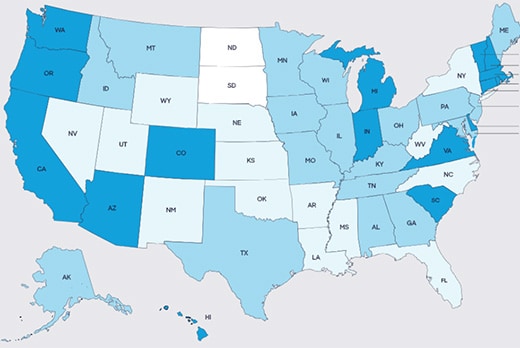Updated: Oct 20, 2023

Article highlights
- Paying for college starts with the FAFSA® (Free Application for Federal Student Aid). It’s used by colleges, states, and the government to offer students financial aid.
- Before taking out student loans, be sure to maximize grants, scholarships, and other sources of free money.
- The application processes for federal and private student loans are different. It’s important to understand each process and stay organized so you don’t miss any deadlines.
Planning to take out student loans? You’re not alone. Federal and private student loans can both help you pay for college. According to the Education Data Initiative, 29% of undergraduate students and 66% of graduate students borrow federal student loans, and 7.2% of students borrow from private student loan lenders like banks.
If you intend to apply for student loans, it’s important to understand the application processes and stay organized so you don’t miss any important steps or deadlines. Not sure where to start the loan process? Here’s what you need to know.
How to apply for federal student loans
1. Fill out the FAFSA
The first step to applying for financial aid and federal student loans is to fill out the FAFSA at studentaid.gov. It is used by colleges, states, and the government to offer financial aid. The FAFSA becomes available on October 1, and since financial aid can be “first come, first served,” it’s important to apply as soon as possible. Pay close attention to the school deadlines since and make sure to submit before their preferred dates. Most students qualify for some financial aid so make don’t let any myths keep you from applying.
2. Read your FAFSA Submission Summary carefully
Within a week after you submit the FAFSA online, you’ll receive your FAFSA Submission Summary via email. Previously known as the Student Aid Report (SAR), the FAFSA Submission Summary summarizes the information you submitted on the FAFSA. It also includes your Student Aid Index (SAI) (previously known as the EFC) and your estimated eligibility for federal grants and loans. It will give you an idea of what kind of financial aid you might expect when you receive your college acceptance letters. When you receive your FAFSA Submission Summary, double-check that all the information is correct. If you find a mistake, you will need to submit a correction.
3. Evaluate your financial aid options
When you receive college acceptances, you’ll also get financial aid award letters, which detail the financial aid each school is offering. The award letter will include grants and scholarships you qualify for along with federal loans. Compare your financial aid award letters side by side with an Award Letter Comparison Tool to help you understand your true cost of attendance after grants and scholarships.
Once you make your college choice, you will need to accept all or some of your financial aid award. If you’re eligible for grants, scholarships, or any other free financial aid, you should accept them first before you take out any student loans. If you need to borrow, compare federal and private student loans and choose the loans that best fit your needs.
4. Accept or apply for your federal student loans
You can accept all, some, or none of the federal loans listed on your award letter online. If you accept federal loans, you’ll need to complete entrance counseling, which is required for all first-time borrowers. Entrance counseling helps you understand the terms and conditions of your loan, as well as your rights and responsibilities. You need to complete it before funds will be disbursed to your school. Once you’ve done that, sign your Master Promissory Note, which is a legal document that outlines your promise to pay back the loan, including interest and fees.
For parents of undergraduate students and graduate or professional students who want to apply for a PLUS Loan, you will need to submit an additional application and undergo a credit check. If approved for a PLUS loan, you will be required to sign your Master Promissory Note, agreeing to the terms of the loan.
How to apply for private student loans
1. Compare federal and private student loans
After maximizing sources of free money such as grants, scholarships, and family contributions and savings, you may still have costs to cover. Research and compare federal and private student loan options to see what best fits your needs. When evaluating private student loans, look at the loan options, APR ranges, fees, and additional benefits.
2. Complete your application
After exploring all your options and shopping around for the right private student loan lender, complete and submit your loan applications. While private student loans don’t have rigid timelines, it may take about a month before you get your school-certified funds. So, give yourself enough time. You’ll want to apply at least 45 to 60 days before you need the student loan to allow for processing time.
3. Add a cosigner to your application, if needed
As part of the loan application, you’ll undergo a credit check. If you don’t have an established credit history or have a low credit score, adding a creditworthy cosigner may increase your chance for loan approval and may help you get a lower interest rate. Cosigners are typically parents or close family members (like grandparents) and could even be a trusted friend.
4. Complete the required paperwork
If you accept a private student loan, you’ll need to sign your promissory note, which is a legal document that outlines your agreement to the terms and conditions of the loan. You’ll also need to complete the Self-Certification Form, which was developed by the US Department of Education to ensure you borrow only what is needed to cover higher education expenses.
5. Accept your loan terms
Once your paperwork is completed and you accept your loan terms, your school will then schedule your disbursements.
From start to finish, finding and securing the right student loans for you can seem like a long journey. But as long as you stay on top of deadlines and requirements, the application process can be smooth.
FAFSA® is a registered trademark of the US Department of Education and is not affiliated with Discover® Student Loans.










